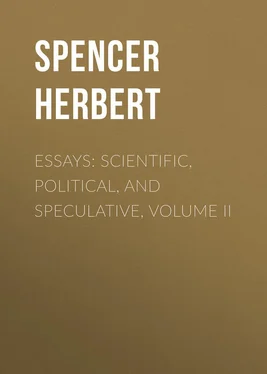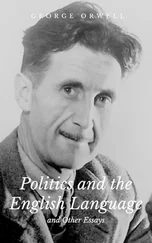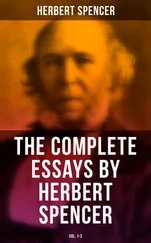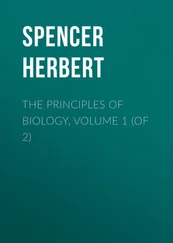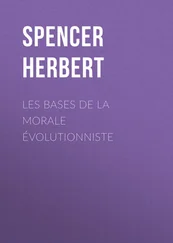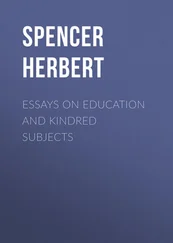Herbert Spencer - Essays - Scientific, Political, and Speculative, Volume II
Здесь есть возможность читать онлайн «Herbert Spencer - Essays - Scientific, Political, and Speculative, Volume II» — ознакомительный отрывок электронной книги совершенно бесплатно, а после прочтения отрывка купить полную версию. В некоторых случаях можно слушать аудио, скачать через торрент в формате fb2 и присутствует краткое содержание. Жанр: Философия, foreign_antique, foreign_prose, sketch, на английском языке. Описание произведения, (предисловие) а так же отзывы посетителей доступны на портале библиотеки ЛибКат.
- Название:Essays: Scientific, Political, and Speculative, Volume II
- Автор:
- Жанр:
- Год:неизвестен
- ISBN:нет данных
- Рейтинг книги:5 / 5. Голосов: 1
-
Избранное:Добавить в избранное
- Отзывы:
-
Ваша оценка:
- 100
- 1
- 2
- 3
- 4
- 5
Essays: Scientific, Political, and Speculative, Volume II: краткое содержание, описание и аннотация
Предлагаем к чтению аннотацию, описание, краткое содержание или предисловие (зависит от того, что написал сам автор книги «Essays: Scientific, Political, and Speculative, Volume II»). Если вы не нашли необходимую информацию о книге — напишите в комментариях, мы постараемся отыскать её.
Essays: Scientific, Political, and Speculative, Volume II — читать онлайн ознакомительный отрывок
Ниже представлен текст книги, разбитый по страницам. Система сохранения места последней прочитанной страницы, позволяет с удобством читать онлайн бесплатно книгу «Essays: Scientific, Political, and Speculative, Volume II», без необходимости каждый раз заново искать на чём Вы остановились. Поставьте закладку, и сможете в любой момент перейти на страницу, на которой закончили чтение.
Интервал:
Закладка:
For when the process of classification has been carried as far as it is possible for the uncivilized to carry it – when the animal kingdom has been grouped not merely into quadrupeds, birds, fishes, and insects, but each of these divided into kinds – when there come to be classes, in each of which the members differ only as individuals, and not specifically; it is clear that there must frequently occur an observation of objects which differ so little as to be indistinguishable. Among several creatures which the savage has killed and carried home, it must often happen that some one, which he wished to identify, is so exactly like another that he cannot tell which is which. Thus, then, there originates the notion of equality . The things which among ourselves are called equal – whether lines, angles, weights, temperatures, sounds or colours – are things which produce in us sensations which cannot be distinguished from each other. It is true that we now apply the word equal chiefly to the separate traits or relations which objects exhibit, and not to those combinations of them constituting our conceptions of the objects; but this limitation of the idea has evidently arisen by analysis. That the notion of equality originated as alleged, will, we think, become obvious on remembering that as there were no artificial objects from which it could have been abstracted, it must have been abstracted from natural objects; and that the various families of the animal kingdom chiefly furnish those natural objects which display the requisite exactitude of likeness.
The experiences out of which this general idea of equality is evolved, give birth at the same time to a more complex idea of equality; or, rather, the process just described generates an idea of equality which further experience separates into two ideas – equality of things and equality of relations . While organic forms occasionally exhibit this perfection of likeness out of which the notion of simple equality arises, they more frequently exhibit only that kind of likeness which we call similarity ; and which is really compound equality. For the similarity of two creatures of the same species but of different sizes, is of the same nature as the similarity of two geometrical figures. In either case, any two parts of the one bear the same ratio to one another, as the homologous parts of the other. Given in a species, the proportions found to exist among the bones, and we may, and zoologists do, predict from any one, the dimensions of the rest; just as, when knowing the proportions subsisting among the parts of a geometrical figure, we may, from the length of one, calculate the others. And if, in the case of similar geometrical figures, the similarity can be established only by proving exactness of proportion among the homologous parts – if we express this relation between two parts in the one, and the corresponding parts in the other, by the formula A is to B as a is to b ; if we otherwise write this, A to B = a to b ; if, consequently, the fact we prove is that the relation of A to B equals the relation of a to b ; then it is manifest that the fundamental conception of similarity is equality of relations . With this explanation we shall be understood when we say that the notion of equality of relations is the basis of all exact reasoning. Already it has been shown that reasoning in general is a recognition of likeness of relations; and here we further find that while the notion of likeness of things ultimately evolves the idea of simple equality, the notion of likeness of relations evolves the idea of equality of relations: of which the one is the concrete germ of exact science, while the other is its abstract germ. Those who cannot understand how the recognition of similarity in creatures of the same kind, can have any alliance with reasoning, will get over the difficulty on remembering that the phenomena among which equality of relations is thus perceived, are phenomena of the same order and are present to the senses at the same time; while those among which developed reason perceives relations, are generally neither of the same order, nor simultaneously present. And if, further, they will call to mind how Cuvier and Owen, from a single part of a creature, as a tooth, construct the rest by a process of reasoning based on this equality of relations, they will see that the two things are intimately connected, remote as they at first seem. But we anticipate. What it concerns us here to observe is, that from familiarity with organic forms there simultaneously arose the ideas of simple equality , and equality of relations .
At the same time, too, and out of the same mental processes, came the first distinct ideas of number . In the earliest stages, the presentation of several like objects produced merely an indefinite conception of multiplicity; as it still does among Australians, and Bushmen, and Damaras, when the number presented exceeds three or four. With such a fact before us we may safely infer that the first clear numerical conception was that of duality as contrasted with unity. And this notion of duality must necessarily have grown up side by side with those of likeness and equality; seeing that it is impossible to recognize the likeness of two things without also perceiving that there are two. From the very beginning the conception of number must have been, as it is still, associated with likeness or equality of the things numbered; and for the purposes of calculation, an ideal equality of the things is assumed. Before any absolutely true numerical results can be reached, it is requisite that the units be absolutely equal . The only way in which we can establish a numerical relationship between things that do not yield us like impressions, is to divide them into parts that do yield us like impressions. Two unlike magnitudes of extension, force, time, weight, or what not, can have their relative amounts estimated, only by means of some small unit that is contained many times in both; and even if we finally write down the greater one as a unit and the other as a fraction of it, we state, in the denominator of the fraction, the number of parts into which the unit must be divided to be comparable with the fraction. It is, indeed, true, that by a modern process of abstraction, we occasionally apply numbers to unequal units, as the furniture at a sale or the various animals on a farm, simply as so many separate entities; but no exact quantitative result can be brought out by calculation with units of this order. And, indeed, it is the distinctive peculiarity of the calculus in general, that it proceeds on the hypothesis of that absolute equality of its abstract units, which no real units possess; and that the exactness of its results holds only in virtue of this hypothesis. The first ideas of number must necessarily then have been derived from like or equal magnitudes as seen chiefly in organic objects; and as the like magnitudes most frequently observed were magnitudes of extension, it follows that geometry and arithmetic had a simultaneous origin.
Not only are the first distinct ideas of number co-ordinate with ideas of likeness and equality, but the first efforts at numeration display the same relationship. On reading accounts of savage tribes, we find that the method of counting by the fingers, still followed by many children, is the aboriginal method. Neglecting the several cases in which the ability to enumerate does not reach even to the number of fingers on one hand, there are many cases in which it does not extend beyond ten – the limit of the simple finger notation. The fact that in so many instances, remote, and seemingly unrelated nations, have adopted ten as their basic number; together with the fact that in the remaining instances the basic number is either five (the fingers of one hand) or twenty (the fingers and toes); of themselves show that the fingers were the original units of numeration. The still surviving use of the word digit , as the general name for a figure in arithmetic, is significant; and it is even said that our word ten (Sax. tyn; Dutch, tien; German, zehn) means in its primitive expanded form two hands . So that, originally, to say there were ten things, was to say there were two hands of them. From all which evidence it is tolerably clear that the earliest mode of conveying the idea of a number of things, was by holding up as many fingers as there were things; that is, by using a symbol which was equal , in respect of multiplicity, to the group symbolized. For which inference there is, indeed, strong confirmation in the statement that our own soldiers spontaneously adopted this device in their dealings with the Turks during the Crimean war. And here it should be remarked that in this re-combination of the notion of equality with that of multiplicity, by which the first steps in numeration are effected, we may see one of the earliest of those inosculations between the diverging branches of science, which are afterwards of perpetual occurrence.
Читать дальшеИнтервал:
Закладка:
Похожие книги на «Essays: Scientific, Political, and Speculative, Volume II»
Представляем Вашему вниманию похожие книги на «Essays: Scientific, Political, and Speculative, Volume II» списком для выбора. Мы отобрали схожую по названию и смыслу литературу в надежде предоставить читателям больше вариантов отыскать новые, интересные, ещё непрочитанные произведения.
Обсуждение, отзывы о книге «Essays: Scientific, Political, and Speculative, Volume II» и просто собственные мнения читателей. Оставьте ваши комментарии, напишите, что Вы думаете о произведении, его смысле или главных героях. Укажите что конкретно понравилось, а что нет, и почему Вы так считаете.
